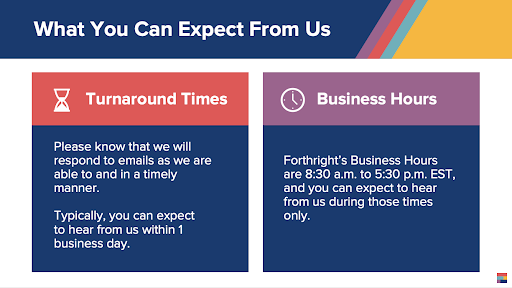Anyone who has worked in client services knows there’s often an expectation to be available for your clients at any hour of the day, no questions asked.
Having spent many years in PR and communications, I once internalized this norm. I thought that serving clients effectively required being hyper-responsive and available at all times, even if I was over capacity and not doing my best work.
So, when I set out to start my own PR firm that exclusively serves child- and family-focused organizations, I knew I didn’t want that life for my team, my clients, or myself. I wanted to be able to care for myself and my team so we could show up as our best selves for our clients and community.
As I was getting Forthright Advising off the ground five years ago, I tried to reimagine a model of client services that worked both for our employees and our clients — a model where happy, healthy teammates have balance.
It started quietly. I tested what would happen if we simply stopped responding to clients outside of our business hours without making a big deal out of it. As it turned out, everything was fine. Our clients were still happy, and our team was happier, too.
Eventually, I decided to formalize this policy, adding the option for clients to pay a premium fee when they requested that we perform after-hours work. (Our team does this work if, and only if, we are available to do so). Sometimes, our clients have true emergencies, and we want to be there for them when that is the case. But we also want to avoid playing into a false sense of urgency.
Initially, I was nervous about launching this policy and thought it might deter our dream clients from working with us. Instead, it has become a valuable screener to ensure we’re working with the right people who share our values of putting people first.
It has become a way to communicate our boundaries and ensure that everyone is working intentionally when we do work outside of business hours. It has allowed me to hire incredible talent and ensure they’re able to do their best work, and it has helped me (and, therefore, my company) thrive.
If you’re curious about implementing this for your own business, read on to learn more about how we’ve launched and communicated this policy, and stuck to it even through moments of uncertainty.
We set a price that would be a ‘stop and think’ moment
We tested a few iterations of how much more we charge for after-hours work and landed on charging around a third more than our usual hourly rate.
This amount is significant enough to make our clients pause and consider whether they really need us after hours, but it’s not so great a deterrent that they can’t swing it in case of emergencies and other unforeseen circumstances.
It was also important to set a rate that would allow me to compensate my employees adequately. The majority of our teammates are women, who I recognize are often still stuck with more of the work at home. I want to pay them more when they’re taking time away from their personal lives or the invisible labor they’re expected to do outside of work.
There’s no magic formula for determining this for your own business. Try to find a rate that’s high enough for clients to respect but not so high to be deeply prohibitive — and don’t be afraid to experiment a bit.
We communicate this policy at multiple touchpoints
We want to ensure our clients are never surprised by this policy during a moment of crisis or confused when they get a higher invoice than they were anticipating, so we over-communicate about it, early and often.
We initially wrote a blog post and LinkedIn announcement to help all of our existing clients understand the change. This lives on our website (rather than just in an email), which has also helped it become part of our brand, so new clients are less likely to be surprised when we bring it up.
In every proposal for a new client or project, we include a rate card that outlines the client’s standard rate and their outside-of-business-hours rate. We also use this as an opportunity to outline what our business hours are and what clients can generally expect in terms of responsiveness both during and after business hours. During the account kickoff with a new client, we reiterate these working norms again.

Finally, when a client does reach out requesting after-hours work, we have a double opt-in moment. First, we check that someone from our team is available to do the work. If so, we then get written approval from the client to charge the higher rate. (If not, we’ll simply reiterate our business hours to the client and let them know that we’ll jump in first thing the next day.)
Sometimes, when we remind clients of the policy, they decide the work isn’t so urgent after all. For instance, we often have West Coast-based clients ask us to join calls that fall outside of our business hours and then realize they can just send us a recap instead, or together, we can simply shift the meeting time.
Regardless, this double opt-in helps avoid surprises and helps everyone be more intentional. The client has to stop and think: Do I really need this right now? And my team has to stop and think: Is there something more important I should be doing with my off hours?
We use pushback as a clarifying moment rather than a combative one
At first, I was surprised by how little pushback we received on this policy. Today, this policy simply feels like an upfront representation of who we are and how we do our best work — and it leads us to clients with shared values. For every client who has questioned it, there are 20 who didn’t even blink. When we do receive that rare pushback, we use it as an opportunity for clarity.
Some clients simply want to fully understand the rules of engagement and how this policy will affect our working relationship, and that’s great. Clarity is kindness and will help us all collaborate better.
For some clients, it’s an opportunity to ask how often true crises show up. If this policy seems to be a sticking point for a potential client, we’ll question how much they expect to need us outside of business hours. Usually, they realize that it’s probably not very often, and we can reassure them that we’ll be by their side during a rare emergency.
Finally, sometimes, it’s an opportunity for us to reflect on whether this is the right client for us. Every so often, we get approached for a true crisis communications project, and we’re simply not set up for that kind of rapid response work.
We’ve also had prospective clients who expect us to be available at all times, and we’ve decided that means we’re not the right fit. And that’s OK — I’d rather prioritize our values and pass on those clients. All of our potential clients work hard to advocate for a better world for kids and families, and when we’re not the best fit, we know it’s important to communicate that clearly so they can find the right partner.
When you shift into seeing a policy as a values alignment screener rather than operating from a scarcity standpoint, it becomes much easier to walk away from the clients who question you.
We always reground in why we’re doing this
That’s what this all comes down to — aligning my business with my values. Forthright’s number one core value is “People First,” and this policy is a way for us to live that value. That’s what I come back to during the rare times I have questioned the decision or considered taking on a non-aligned client against my better judgment.
Living this value and setting these boundaries has undoubtedly made my business stronger and kept our clients happy. I’ve been able to attract amazing talent because they see that our company truly respects work-life balance. Because our teammates have guarded time to rest and recharge, they can bring their best selves to work and do a better job for our clients. And as a founder, I’m able to care for my own health and happiness, which is central to the health and happiness of the business.
While this may not be the exact boundary that works for you, it’s important to identify where your energy gets zapped the most and what you can do to make the business more sustainable for yourself and your teammates. Owning a business is hard enough — why make it harder on yourself?
Try Buffer for free
190,000+ creators, small businesses, and marketers use Buffer to grow their audiences every month.




